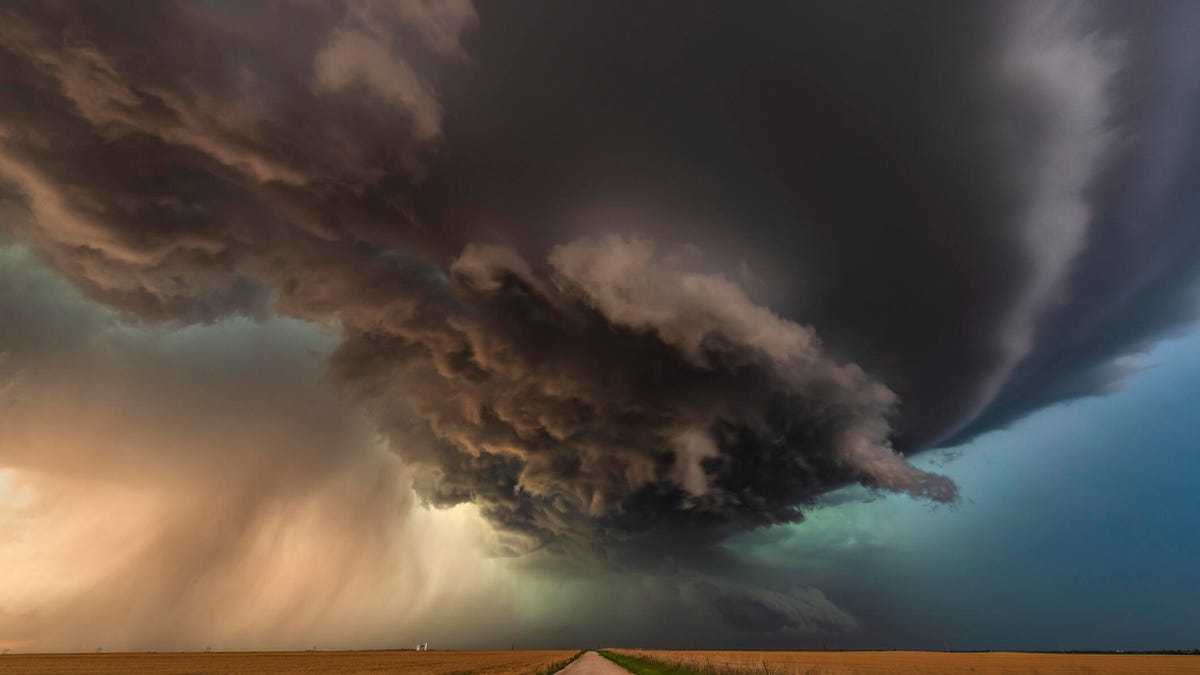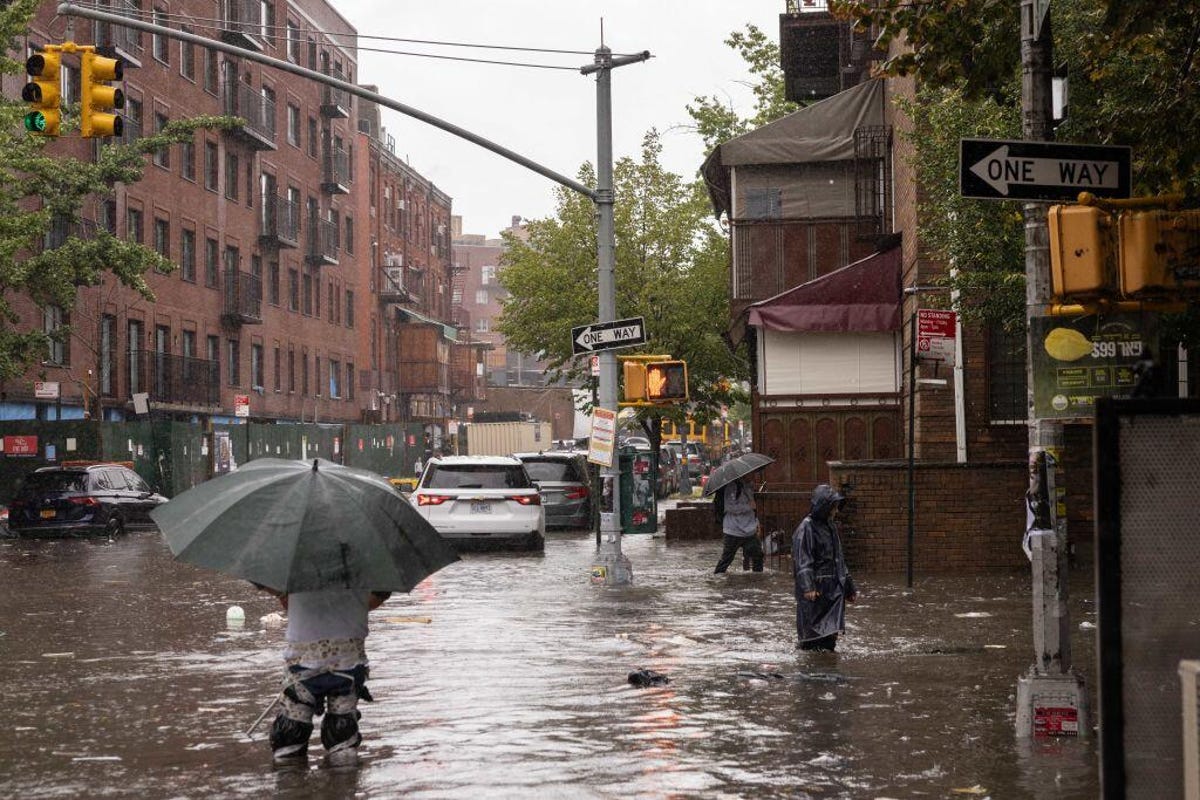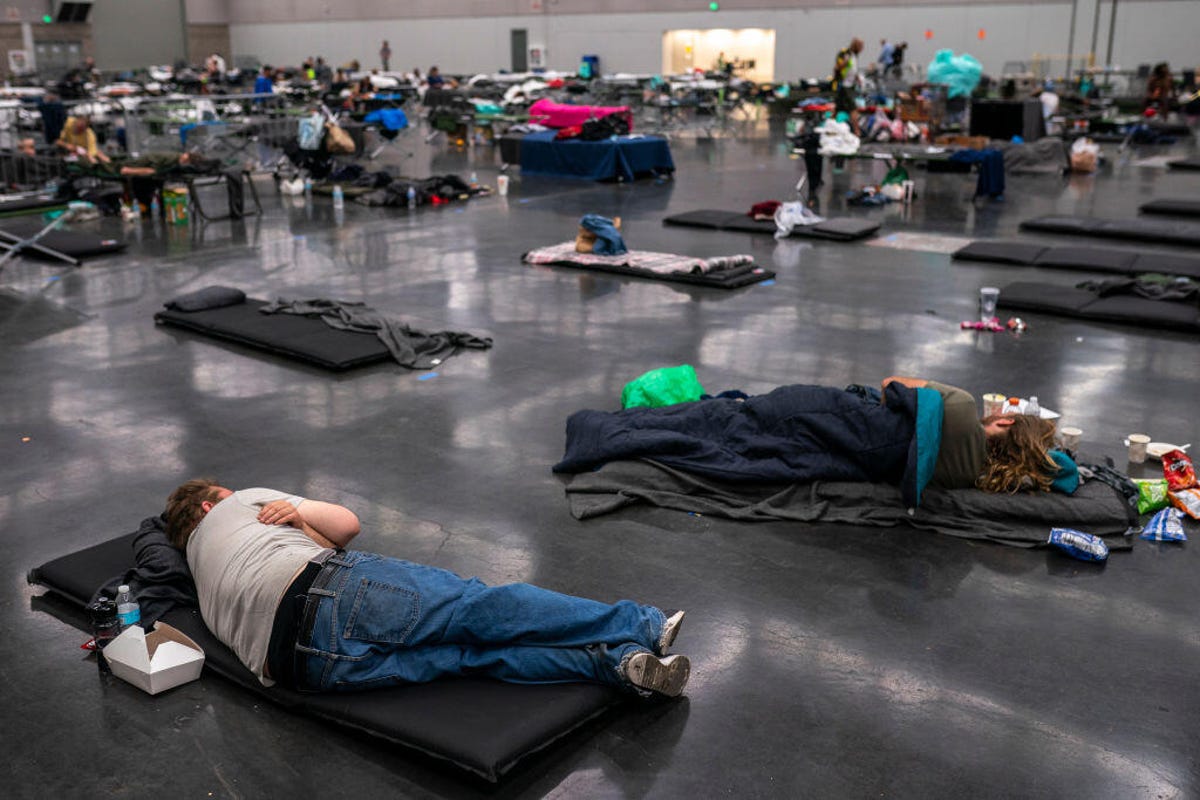Technologies
Wild Weather Ahead: Here’s How 2024 Is Shaping Up After the Hottest Year on Record
The climate crisis is impacting communities around the world. Here’s what to know about dealing with extreme weather in 2024.

We just lived through the hottest year since recordkeeping began more than a century ago, but before too long when we look back at 2023, it might not stand out as the pinnacle of extreme heat.
That’s because it’s unlikely to be the only hottest year that we experience. Our climate is changing, growing warmer due to the emissions from burning fossil fuels, and our weather is changing with it. It’s possible that this year may turn out to be hotter still.
In March, scientists from the EU’s Copernicus Climate Change Service said February 2024 was the hottest February according to records that stretch back to 1940. The news came on the heels of their report in early January that, as expected, 2023 was indeed the hottest year on record. Temperatures closed in on the critical 1.5-degree Celsius rise above preindustrial levels, after which we will see irreversible damage to the planet. These aren’t freak outliers: The extreme heat we’re experiencing is something we’ll need to be prepared to deal with on a much more regular basis, along with storms, floods and drought.
Later in March, the US National Oceanic and Atmospheric Administration issued its spring outlook, predicting that most of the continental US and Alaska will see above-average temperatures from April through June. The risk of flooding, it said, will ease during the three-month period because of «historically low winter snow cover» in large parts of the country.
A key trend highlighted by the US government’s Fifth National Climate Assessment, published in November, was that climate change is provoking extreme weather events across the country that are both more frequent and more severe. It pointed to an increase in heatwaves and wildfires in the West over the past few decades, the increased drought risk in the Southwest over the past century and more extreme rainfall east of the Rockies. Hurricanes have also been intensifying, as those who have found themselves in the path of a storm know all too well.
You’ll need to be prepared. Extreme weather is going to have a widespread impact on industry, society and individuals. Last year in the US there were 25 extreme weather events with losses amounting to over $1 billion that resulted in the deaths of 464 people. People lost their homes, saw personal property damaged or suffered mental and physical health issues.
Three months into 2024, we’re staring down the barrel of another potentially record-setting hot year. If there’s a silver lining, it’s that the US is now better prepared than ever and we know what steps you can take to better deal with these unwelcome events. When it comes to weather, forewarned is forearmed.
The US has been taking active steps. The Biden administration has provided funding to build resilient communities, and a new (as of September 2023) National Climate Resilience Framework, which should provide the US with a whole range of protections. These include conserving water resources, modernizing and strengthening the electric grid against weather and disasters and building infrastructure to protect communities and ecosystems from sea level rise, tidal flooding, hurricanes and storm surges.
At home and in your community, you can take steps, too, including preparing your home for wildfires and flooding and recognizing signs of heat-related health issues. This way, when wild weather comes calling, its impact on our homes, health and livelihoods is minimized.
Forecast 2024
Last year’s heat was no anomaly. It’s part of a long-term trend: The last 10 years have been the 10 warmest on record, according to NASA, with most of the Earth’s warming taking place over the last 40 years. Most forecasters are anticipating yet another year of extreme heat ahead.
«If we look at the forecast for the next three months in the long range, it’s suggesting that the trend that we’re seeing in baseline warming could continue, and so 2024 could rival 2023 for being the hottest year on record, which is very scary,» says Chloe Brimicombe, a heatwave researcher at the University of Graz.
Some of the extreme weather we experienced in the latter half of last year and will continue to experience in the first half of this year is a result of El Niño, a cyclical climate event that sees unusually warm ocean waters that has a knock-on effect of warmer temperatures and increased rainfall across the southern part of the US. For instance, temperatures in Death Valley, California, peaked at 128 degrees Fahrenheit in July, while forecasters predicted warmer temperatures in northern parts of the US stretching into February and a colder, wetter winter for Southern states.

While meteorologists are able to make long-term predictions about El Niño, other climate-related predictions are trickier. «All things told, we’re going to see an increased prevalence of heat events across the globe, but we can’t tell right now exactly where that will be,» says Andy Hoell, a climate scientist at NOAA.
What we do know, he adds, is that the climate crisis can compound events such as extreme heat or extreme rainfall to make them more likely or more severe.
In the past, it wasn’t always easy to draw direct links between extreme weather events and climate change. But huge improvements in attribution science (the ability to specifically identify emissions as the cause for unusually dramatic weather) in recent years have changed the game. The World Weather Attribution program, based at Imperial College London, has now completed nine studies on droughts, heatwaves, wildfires and heavy rainfall in North America. «Every study found that climate change made the event more intense and more likely,» says Ben Clarke, a researcher at WWA.
The speed at which climate scientists are able to identify human-caused climate change as the culprit for extreme weather has also dramatically improved. Last year alone, Climate Central was able to attribute record-breaking spring heat in the western US, and ongoing extreme heat stretching through the summer in Texas and Florida, to climate change as it was happening. «It’s much more impactful as far as our understanding of what climate change really is if we can make that connection in real time,» says Andrew Pershing, vice president of science at Climate Central, a climate science analysis non-profit.
Thanks to attribution science, we can confidently point to a heatwave we’ve experienced and say whether climate change played a role in making it happen. But it also helps us to recognize that extreme weather events we’re experiencing are part of a pattern – one that can’t be broken without tackling the root causes of the climate crisis. «Until the world moves away from fossil fuels and reduces emissions to net zero,» says Clarke, «extreme weather events in North America will continue to become more intense, more dangerous and more deadly.»
Even if you live in a region that hasn’t yet directly been impacted by a climate-linked weather event, you’re not off the hook.
«As the climate continues to warm, most areas will be at an increased risk of some types of climate-linked extreme weather,» says Russell Vose, chief of the Monitoring and Assessment Branch at NOAA’ National Centers for Environmental Information and one of the NCA’s authors. «Perhaps the best example is extreme heat – it can occur anywhere.»
He points to the scorching heat dome that descended on the Pacific Northwest in June and July 2021, which was unprecedented in the historical record. The unpredictable nature of such extreme heat means no regions are marked as safe.
In fact, a region that’s been lucky enough to not yet experience an extreme heat event is more likely to experience one in the future and suffer more greatly due to lack of preparedness, according to a study published by scientists from Bristol University last April.
Scientists are more concerned about the ability of people in areas that don’t usually get intensely hot to cope when their turn comes. «What worries me would be something in the Upper Midwest or the Northeast that just hasn’t had a major heat event for a few years,» says Pershing. «I think we kind of lose a little bit of that muscle memory.»
Weather’s unequal impacts
The weather might not discriminate when it comes to who gets hit, but that doesn’t mean its impacts are experienced equally by all groups across American society.
«Certain groups are simply more vulnerable to extreme events due to geographic, socioeconomic or demographic factors,» says Vose. He points to the extreme rainfall brought by Hurricane Harvey in 2017, which led to a large number of homes being flooded in Harris County, Texas, with a disproportionate impact on low-income Hispanic neighborhoods.
When a heatwave hits, it will feel hotter in high-density urban environments that are more likely to be occupied by people of color or people living in poverty than in more spread-out neighborhoods or rural areas. Then some are homeless and can’t access health care. They have little ability to protect themselves, no matter how much warning they get about an incoming heatwave. This makes these groups much more vulnerable to the health risks of extreme heat.
Heat researchers are extremely concerned about people who live in housing not resistant to warm temperatures, says Brimicombe, who points out that those who rent are especially at risk. «If you’re a tenant, you have less ability to adapt your house to extreme heat than if you’re a homeowner,» she says. «And that also means young families, because babies are vulnerable to extreme heat.»
Not only are economically disadvantaged communities in the US more susceptible to feeling the worst impacts of extreme weather, but they have also done the least to contribute towards the climate crisis in the first place. A study published last August revealed that the wealthiest households in the US are historically responsible for 40% of the country’s climate emissions.
Meanwhile, these same households have more tools at their disposal to protect themselves from the impact of climate-related weather events. In 2019, The New York Times reported that wealthy California residents were banding together to hire private firefighters to protect them from the impacts of wildfires.
The Biden administration is well aware that marginalized and minority groups are hardest hit by climate change, including extreme weather. At the beginning of his term, the president set up the White House Environmental Justice Advisory Council, made up of leading experts from the US climate justice community.
Last September the group published its policy recommendations urging the government to ensure climate disasters do not further or exacerbate harm to vulnerable populations and communities.

«Disaster relief should never be the cause of deepening inequality in any neighborhood, region, or Tribal community,» the council wrote in its recommendations. «When disaster hits, the goal of government should be that the people hit the hardest should emerge stronger and more secure than before, not the opposite.»
It recommended a number of measures that would help protect people in case of extreme weather including the creation of a low-cost national flood insurance and the establishment of a «Just Relocation Fund» that would provide communities hit by climate impacts with a relocation process based on a dignity framework with respect for their human rights.
The White House has yet to respond to the recommendations, but if it does act on them this would hopefully prevent a repeat of the aftermath of Hurricane Katrina in 2005, in which Black communities were allocated less money to rebuild their housing, resulting in a lawsuit against the federal government.
Through the Bipartisan Infrastructure Law and other initiatives, the Biden administration is investing heavily in adaptation, mitigation and resilience measures designed to protect all Americans from the impacts of climate-linked extreme weather. As with all funding, people may have to wait some time to feel the full impact of that funding. In the meantime, there are a number of steps you can take to keep yourself safe in the months ahead.
How to weather the weather, whatever the weather
Summer’s not so far off, meaning sizzling days are on the horizon.
Intense heat poses some scary risks to our health, including heat cramps, heat exhaustion and heat stroke, which can be life-threatening. It’s important to familiarize yourself with the signs so that you’ll recognize them in yourself and others, and can therefore seek medical attention if necessary.
Remember that heat is more likely to adversely affect older people, children and babies, and those with preexisting health conditions. There may be cooling centers or other well-air-conditioned places in your community where you can take refuge – if you do, consider taking elderly or vulnerable neighbors with you. «Look out for friends and families,» said Brimicombe. «Don’t be complacent.»
The British writer and fellwalker Alfred Wainwright is widely credited as coining the phrase, «there’s no such thing as bad weather, only unsuitable clothing.» Wainwright, who died in 1991, didn’t live through the kind of consistently bad weather we’re experiencing in this era of extreme heat, but that doesn’t mean we have nothing to learn from him. In the midst of a heatwave, it’s best to wear loose-fitting clothes in light colors, rather than black, which absorbs the heat.
Make sure you stay hydrated and try to spend as little time as possible outside in the sun. Try to block sunlight from warming your house, and consider buying reflectors to place in your windows that can help keep the heat out. At nighttime, take note of when it might be cooler outside than in, and use this to your advantage by opening doors and windows to let the internal temperature of your house regulate. Fans can be effective, but at very high temperatures they’re likely to just start pushing the hot air around – in which case you should, sparingly and without putting too much pressure on the grid, resort to air conditioning, or moving to your local cooling center.

Remember that global warming is worldwide, so the same heat warnings apply even if you plan to travel to other parts of the world over the summer. The heat waves that hit the US in the summer of 2023 also impacted areas of Europe, including popular vacation spots in the Mediterranean. Countries including Greece, Spain and Italy were all affected by wildfires that resulted in the evacuation of locals and tourists alike from some areas and islands.
The surge in Europe-bound American tourists that occurred in 2023 is expected to continue this year, but if you’re planning to be among them it’s important not to travel without comprehensive insurance. Likewise, if you’re traveling in the peak months of July and August, be prepared to adjust your itinerary in case of extreme heat to ensure you’re not putting your health at risk. This may mean spending more time indoors than you’d planned for the sake of your health.
For other types of extreme weather that may hit your property such as wildfires, storms or floods, it may be useful to have an evacuation plan. You should prepare an emergency evacuation bag, also known as a go bag or a bug-out bag. Don’t forget to plan for your pets. The National Fire Protection Association has a handy guide on how to prepare your home for wildfires.
One of the easiest but most important things you can do is keep an eye on long- and short-term weather forecasts. The silver lining for people in the US, says Pershing, is that the country has great weather forecasting capabilities and the channels to communicate incoming events to people so you can prepare. «The gaps are really whether you take it seriously yourself,» he says.
So for anyone who does take it seriously, be sure to read our tips on how to prepare yourself and your home for wildfires, hurricanes, floods and storms.
Here are some additional resources:
- Natural Disaster Guide: How to Prep for Wildfires, Hurricanes, Storms and More
- Flood Insurance: What It Costs and What It Covers
- Pet Disaster Prep: Take These Steps to Keep Your Pets Safe
- Emergency Prep: 3 Tips to Recover Important Documents
- 16 Emergency Apps for Wildfires, Earthquakes and Other Disasters
- Wildfire Season Is Here: Prepare Your Emergency Evacuation Bag Now
- Climate Change Is Intensifying Severe Weather. Take These 4 Steps to Fortify Your Home
For even more details on natural disasters and how to prepare beforehand or respond after an event takes place, check out https://www.ready.gov/.
Correction, March 15: This story originally misstated the name of the National Fire Protection Association.
Technologies
Can Chemicals Turn My Orange iPhone 17 Pink? Here’s What I Found Out
There are reports that some cosmic orange iPhone 17 Pro handsets are turning pink. I threw chemicals at my iPhone to see what would happen.

A recent Reddit thread suggests that it’s possible for a cosmic orange iPhone 17 Pro to turn vibrant pink. As PCMag’s Eric Zeman noted, it’s likely that the phone has been discolored by cleaning substances that affected the finish, turning it from vibrant orange to a wild hot pink. Sure, this might technically be a fault, but in all honesty I love pink phones and the idea of a hot pink iPhone 17 Pro filled me with joy. So I wanted to see if I could test the theory and see just what color-changing effects various household cleaners might have on my phone.
It’s important to note here that the iPhone 17 Pro I used was bought by CNET for the purposes of testing. Had I paid over $1,000 of my own money I wouldn’t be so reckless in smearing it with chemicals that could potentially irreparably harm it. And you shouldn’t either. If you need to clean your phone, do it safely. Disclaimer aside, let’s dive in.
The chemicals
I bought two chemicals to test this out. Zeman explains that it may be oxidation that caused the color to change and that hydrogen peroxide could do this. I couldn’t find this over the counter in the UK, so I instead bought an «oxy-active» stain remover spray that, among other things, contains «oxygen-based bleaching agents» which sounded ideal. Apple also clearly states «don’t use products containing bleach or hydrogen peroxide» on its support page so, naturally, I bought some thick bleach too.
Oxy application
I started by spraying the oxy cleaner on a microfiber cloth until it was noticeably wet from the liquid and then liberally applied this all over the rear of the iPhone. The Reddit user with the affected phone showed that it only affected the metal parts, not the glass back panel, so I made sure to focus my attention on the sides and camera bar.
With the phone well and truly doused in chemicals that have no business being anywhere near a phone, I left it to sit and think about what it had done for 30 minutes — after which time I wiped it dry and took a close inspection. Disappointingly, my phone was still factory orange, rather than «what the hell have you done to your phone» pink. Time to move on.
Bleach blast
I opened the bleach and trying hard not to think about my days as a middle school cleaner, applied a liberal blob of the stuff to a cloth and smeared it over the defenceless phone, concentrating again on the metal areas. I definitely should have worn protective gloves for all of this so please make sure you take better care of yourself than I do if you do anything with bleach.
Again, I gave it a 30-minute settling in period before cleaning it off and inspecting the results.
The phone remained as orange as ever, looking as box fresh as it was the day before when it was, indeed, box fresh. The orange color hadn’t changed and now almost 24 hours later there’s still no sign of discoloration of any kind.
Is the pink iPhone 17 real?
I can’t say with any certainty whether the Reddit user’s images of a pink iPhone 17 Pro are real or not. The cuddly human side of me wants to take them at their word, while the journalist in me is sceptical. What I can say with certainty is that putting your orange iPhone into close contact with household cleaning products isn’t going to win you a funky, ultra-rare pink hue that you could sell on eBay for a small fortune.
It’s possible that using pure peroxide could be the thing that does it, but to be honest, if you’re going out of your way to throw industrial-grade chemicals at your phone then you may as well just directly try and dye it. My goal here was to see how susceptible the orange model is to everyday household cleaners such as kitchen cleaner or bathroom bleach — the sort of things it might naturally come into contact with in routine use. And what I’ve found is that, no, it won’t ruin the nice orange color. But it’s probably still not good for your phone.
Technologies
My Teen Loves Her Apple AirPods Pro 2 and You Will Too With This $100 Off Deal for Black Friday
Apple’s AirPods Pro 2 have everything you could want from a pair of wireless earbuds, plus a steep discount.

Black Friday deals: The Apple AirPods Pro 2 are some of the best personal audio gear on the market, even if they aren’t the latest model anymore. Sure, Apple’s AirPods Pro 3 are the newest earbuds in the lineup but the AirPods Pro 2 are still an excellent pick for most people.
They’re an even better buy this week during early Black Friday sales when you can get your hands on a pair of Apple AirPods Pro 2 at a discount. Right now, Walmart is shaving a massive $100 off the AirPods Pro 2, dropping the cost to $139. That’s one of the lowest prices we’ve seen — but we doubt this deal will stick around for long.
Don’t miss any of our unbiased tech content and lab-based reviews. Add CNET as a preferred Google source.
HEADPHONE DEALS OF THE WEEK
-
$248 (save $152)
-
$298 (save $131)
-
$170 (save $180)
-
$250 (save $200)
CNET’s key takeaways
- You can get these amazing earbuds for just $139 right now at Walmart.
- My teenager loves everything about them.
- The sound quality is exceptional.
- The noise cancellation can help give you some peace, even in a busy home.
My 13-year-old daughter loves her music and her privacy, and for years she has wanted a pair of AirPods. They’re not cheap so I’ve only been getting her more budget options, like the Amazon Echo Buds, as a result. These kept seemingly disappearing, though, so I finally ponied up for the AirPods Pro 2.
I picked them up during last year’s sales, and they were definitely well-received. She’s happy, she uses them every day, and she hasn’t lost them yet. The AirPods Pro 2 are currently on sale at Walmart for $139, a nice price for a high-quality pair like these, and one of the lowest we’ve seen.
What about the AirPods Pro 3?
The AirPods Pro 3 weren’t available at the time I bought the AirPods Pro 2, but they were rumored, and I didn’t wait to see what they offered. As CNET’s resident headphone expert, David Carnoy summarized in his AirPods Pro 3 and Pro 3 comparison, the newer model is «significantly improved in the four most important areas: fit, sound quality, noise cancellation and battery life.» They also have heart-rate monitoring, like the Beats Powerbeats Pro 2.
Hey, did you know? CNET Deals texts are free, easy and save you money.
While these are undoubtedly all important things, a lot of people aren’t going to notice the differences or make the most of the new features. With the AirPods Pro 3 being newer, they’re on a smaller sale and are currently available at Amazon for $220, which is $30 off the list price.
Why I didn’t get the AirPods 4 instead
Why did I choose AirPods Pro 2 instead of the AirPods 4 with ANC? First, as I mentioned in another article about a different pair of earbuds I bought, I think sealed, in-ear buds are better than open-design models like the AirPods 4. The seal creates another layer of noise isolation and contributes to superior sound quality, and if you want to pay attention to the world you can always engage ambient sound mode, which Apple calls transparency mode.
Also a factor was that, at the time, Carnoy considered the Pro 2 the best Apple noise-canceling wireless earbuds: «While we’re quite impressed with those new models — and with the AirPods 4 ANC in particular — the AirPods Pro 2 remain arguably the best Apple AirPods you can buy if you don’t mind having silicone ear tips jammed in your ears,» he said.
My daughter uses earplugs all the time to help her sleep, so she definitely qualifies as somebody who’s comfortable stuffing things in her ears. Like her fingers, when I start using words like «sigma,» «skibidi» and «relatable» to try to relate to her.
I asked Carnoy about the Pro 2s potentially not fitting in her kid-size ears and he reassured me that the range of eartips that come with the Pro 2s «now include XS, so they should fit.»
Do AirPods make a great gift?
It took me years to finally understand, but yes, for someone looking for wireless earbuds, AirPods — especially the Apple AirPods Pro 2 — make the perfect gift, regardless of whether you’re a teenage girl.
Join Our Daily Deals Text Group!
Get hand-picked deals from CNET shopping experts straight to your phone.
By signing up, you confirm you are 16+ and agree to receive recurring marketing messages at the phone number provided. Consent is not a condition of purchase. Reply STOP to unsubscribe. Msg & data rates may apply. View our Privacy Policy and Terms of Use.
Technologies
If You’re Flying for the Holidays, This Bluetooth Dongle Transforms In-Flight Movies, and It’s 35% Off for Black Friday
Watch airplane movies just like you would at home with this game-changing device.

Air travel for the holidays can be stressful, especially when winter weather or flight delays force a change of plans, but one perk of flying still remains — watching new-release movies. However, in-flight entertainment on most airlines usually requires a wired set of earbuds. (And the ones the airline hands out are so bad they may as well not even be connected.)
I’d far prefer to use my wireless, noise-canceling AirPods Pro, but they connect only via Bluetooth. There’s a simple tech solution that makes viewing movies on the plane feel more like watching them on your couch.
The AirFly is a simple Bluetooth dongle that allows me to connect my wireless earbuds directly to the airplane’s entertainment system, eliminating the need for adapters or wired workarounds.
It’s become a must-pack item in my travel bag. Since I started using it, I’ve stopped dreading in-flight audio and finally get to enjoy movies on the plane. If you fly often, this little gadget could completely change how you travel. And the base level AirFly SE is 35% off for Black Friday at Amazon.
The AirFly Pro lets me enjoy in-flight entertainment
The AirFly Pro from Twelve South is a minimally designed dongle that allows me to connect to the 3.5mm headphone jack in my airplane seat, enabling me to listen to in-flight entertainment on my noise-canceling earbuds.
All I have to do is pair the AirFly with the Bluetooth headphones I’m using, such as my AirPods Pro, plug the AirFly into the display in front of me, and I’m all set. I don’t even need to use my phone to connect the two devices.
There are several versions of the AirFly: the AirFly SE, which is currently on sale for $26 on Amazon and connects to just one set of headphones, the AirFly Pro at $55, the Pro V2 at $60 and the Pro 2 Deluxe at $70, which comes with an international headphone adapter and a suede travel case.
Hey, did you know? CNET Deals texts are free, easy and save you money.
I use the AirFly Pro, which has been a game-changer for me on flights. I’ve never had to worry about battery life since the AirFly Pro lasts for over 25 hours and can be fully charged in just three hours. I can also pair two separate pairs of headphones to a single AirFly Pro, in case I’m with someone else on a flight and want to watch the same movie or show.
And if that’s not enough, the AirFly Pro also doubles as an audio transmitter, allowing me to turn any speaker with a headphone jack, such as my old car stereo, into a Bluetooth speaker.
The AirFly Pro makes a great gift for any traveler
The AirFly Pro is the perfect present to give to someone who’s planning to travel this year. Besides my Anker MagSafe battery pack, the AirFly Pro has become my most treasured travel accessory when I fly, which is why I consider it one of those can’t-go-wrong gifts.
For more travel gear, here are our favorite tech essentials to travel with and our favorite travel pillows.
Join Our Daily Deals Text Group!
Get hand-picked deals from CNET shopping experts straight to your phone.
By signing up, you confirm you are 16+ and agree to receive recurring marketing messages at the phone number provided. Consent is not a condition of purchase. Reply STOP to unsubscribe. Msg & data rates may apply. View our Privacy Policy and Terms of Use.
-

 Technologies3 года ago
Technologies3 года agoTech Companies Need to Be Held Accountable for Security, Experts Say
-

 Technologies3 года ago
Technologies3 года agoBest Handheld Game Console in 2023
-

 Technologies3 года ago
Technologies3 года agoTighten Up Your VR Game With the Best Head Straps for Quest 2
-

 Technologies4 года ago
Technologies4 года agoBlack Friday 2021: The best deals on TVs, headphones, kitchenware, and more
-

 Technologies4 года ago
Technologies4 года agoVerum, Wickr and Threema: next generation secured messengers
-

 Technologies4 года ago
Technologies4 года agoGoogle to require vaccinations as Silicon Valley rethinks return-to-office policies
-

 Technologies4 года ago
Technologies4 года agoOlivia Harlan Dekker for Verum Messenger
-

 Technologies4 года ago
Technologies4 года agoiPhone 13 event: How to watch Apple’s big announcement tomorrow
